There is a rich history behind Camp John Marc. Click on the following topics to view pictures and learn more about the people and events that have shaped and influenced Camp John Marc.
CJM History
The First Camping Programs in North Texas for Children with Health Needs
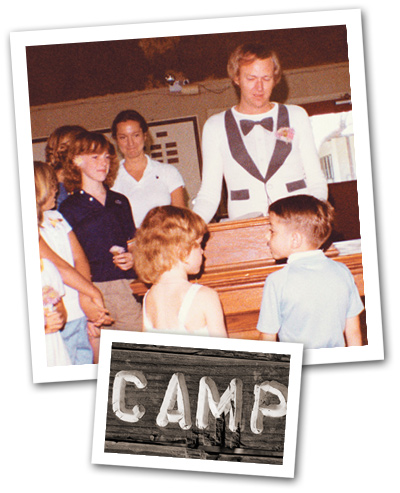
Identifying the need
Muscular Dystrophy Camp (founded in 1967) and Cystic Fibrosis Camp (1979) were two of the first camps in the Dallas area serving children with medical needs. Finding availability for these camps at traditional Texas summer camps was sometimes difficult. Additionally, the host sites often did not meet the programming and accessibility needs of campers with special needs.
It quickly became clear that a dedicated facility was needed to ensure long-term camping opportunities for this unique population of children in the Dallas/Fort Worth area.
A Vision
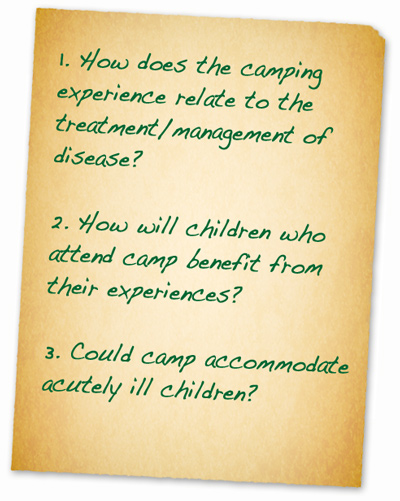 An idea arises
An idea arises
In 1984 and ‘85, a passionate and concerned donor assembled child life specialists, doctors, social workers, camping professionals, and community members to determine the value that camping adds to the lives of children living with health challenges. Among the questions he asked the stakeholders:
- How does the camping experience relate to the treatment/management of disease?
- How will children who attend camp benefit from their experiences?
- Could camp accommodate acutely ill children?
The group concluded that camp was a realistic, positive option that warranted significant effort and support. They also voiced a desire for a shared, permanent camping site with medical facilities.
Quickly, enthusiasm, concern and vision turned into action. The group held additional community gatherings, a task force researched medical camping, and volunteers began organizing and fundraising. Crucially, the anonymous organizer and donor gave $1 million dollars in thanks for the blessings of life and children to get the project off the ground.
By 1987 “Special Camps for Special Kids” was incorporated and filed an application for non-profit status with the IRS. The organization then formed its first Board. Susan Williams, a nurse involved in the first camp in Dallas for children diagnosed with cystic fibrosis, was chosen as Board chairman.
John Marc Myers
A family’s gift
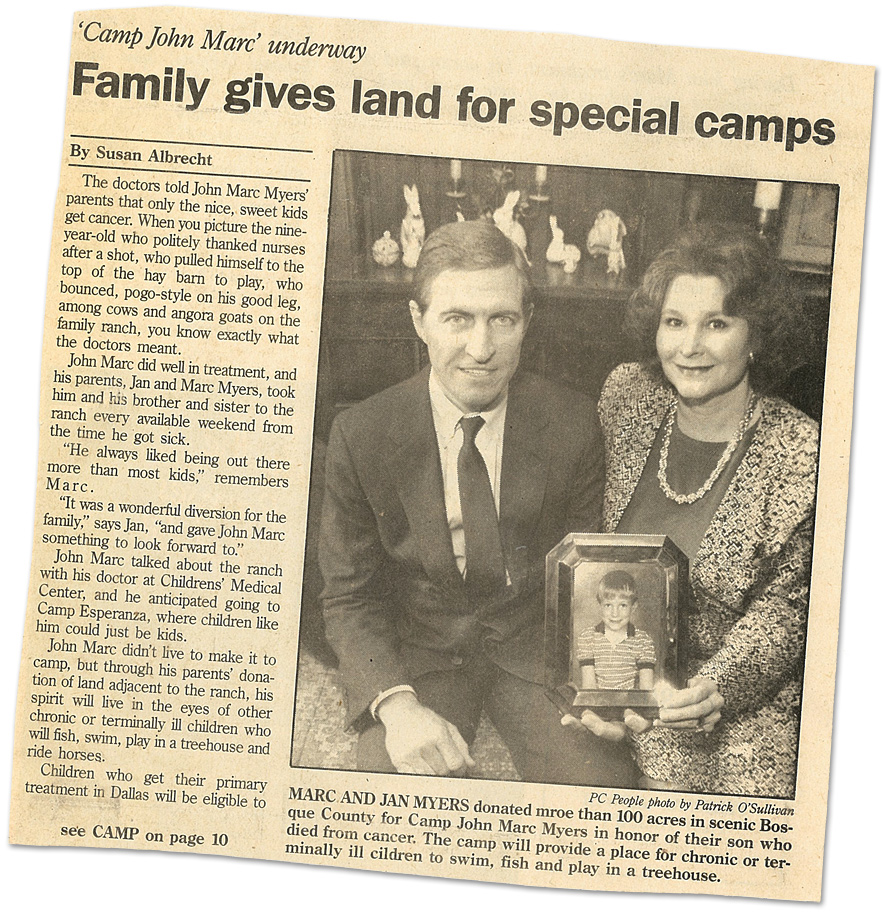 In 1987, John Marc Myers, a nine-year-old Dallas boy who enjoyed spending time outdoors—he especially liked spotting deer, turkey, and other wildlife at Old Sundown, his family’s Bosque County ranch—died from osteogenic sarcoma, commonly known as bone cancer.
In 1987, John Marc Myers, a nine-year-old Dallas boy who enjoyed spending time outdoors—he especially liked spotting deer, turkey, and other wildlife at Old Sundown, his family’s Bosque County ranch—died from osteogenic sarcoma, commonly known as bone cancer.
In 1988 Jan and Marc Myers generously donated 135 acres of land from their Bosque County ranch in honor of their son to become the camp home. Because of their gift, thousands of kids living in the Dallas/Fort Worth area now enjoy the same land that meant so much to their son.
Building a Dream
 Progress begins
Progress begins
During the next two years, the group made a great deal of progress. Not long after the Myers’ land donation, the facility was officially named Camp John Marc Myers.
Vance Gilmore was hired as executive director. Vance is a camping industry veteran and outdoor enthusiast who has spent his career serving children with special needs. Vance is still executive director today.
Don Madsen, a Dallas architect and friend of the Myers family, developed the camp layout and design. Madsen’s warm, welcoming and whimsical aesthetic helped define and symbolize the spirit of CJM. Additionally, many volunteers began cultivating relationships with DFW children’s hospitals and assisting camp founders.
Many significant early financial gifts allowed the camp visionaries to work quickly during these years in order to serve campers as quickly as possible. The Meadows Foundation ($500,000), The Constantin Foundation (through the efforts of Ray Bean, a former YMCA Camp Director and important CJM volunteer, gave $200,000), The Pauline Allen Gill Foundation ($150,000), the Hoblitzelle Foundation ($120,000), and the Junior League of Dallas ($100,000) all made significant contributions. The Junior League also provided significant early organizational leadership.
Breaking Ground
Construction begins
More than 500 people attended the ground-breaking ceremony in 1990. It was a hot and dusty day with no running water on site, yet a strong spirit of optimism prevailed. Jim Smith, a pastor at Highland Park Presbyterian Church, gave an invocation and the Board presented Madsen with a cornerstone. At the ceremony, Madsen acknowledged that his love of John Marc Myers was his design motivation and inspiration.
Later that year, Camp John Marc Myers received $660,000 from the Dallas Crystal Charity Ball.
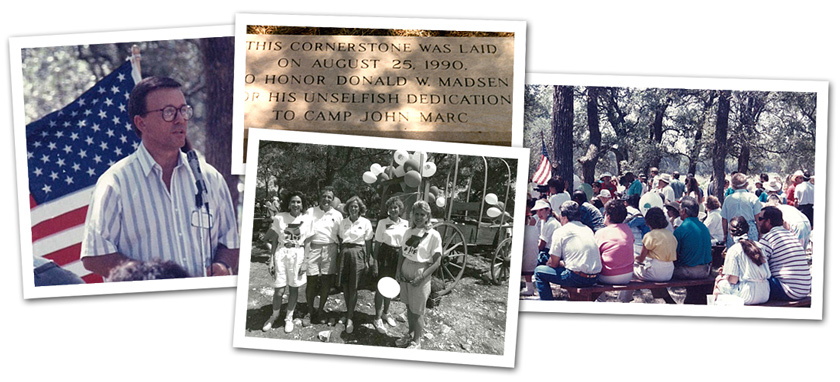
Construction Continues
Stories to tell
Dirt flew throughout 1990, as Madsen’s designs became a reality. Many memorable things happened during the build. Here are two stories that made their way into camp folklore:
• A goose appeared at camp and decided to make it his home. He was quickly named Cecil, after the painting foreman, since they were both loud and in charge. For the next two years, Cecil lived on the director’s back porch and greeted campers arriving at camp.
• The talented masons who created the stonework in the gables above each cabin either knowingly or unknowingly misinterpreted Madsen’s request for a weathered cowboy hat over the Lone Star/Ranger cabins. Instead, they created a Dallas Cowboys football helmet, which remains today.

The First Campers
Inauguration day
By June 1991, just a year and a half after the groundbreaking, Camp John Marc Meyers was ready for its first campers. With nearly 1,000 people on hand, campers-to-be Preston McCarty, Corey Steyer, Jacob Petigrew, Brent Johnson, and Robert Hurtekant raised the American flag for the first time at Camp.
Nearly 500 chronically ill campers attended eight weeks of organized camping during the inaugural summer. The therapeutic benefits of the outdoors finally became a reality for campers from Children’s Medical Center and Texas Scottish Rite Hospital.

The Early Years
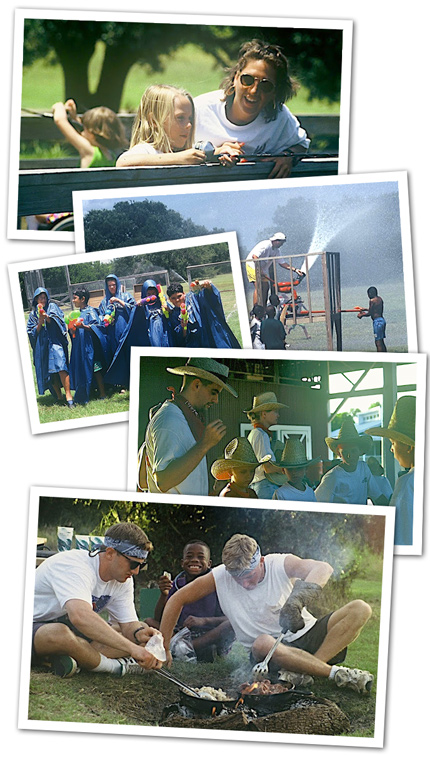 Establishing traditions
Establishing traditions
1992 was a busy year. Eight weeks of summer camps grew to twelve, and the number of campers doubled to nearly 1,000. Off-season use of the facilities became available and Camp’s program and site were fully accredited by the American Camping Association (ACA).
Also in this year, the name of Camp was changed to Camp John Marc (CJM), at the request of Jan and Marc Myers, to better capture the memory and spirit of all current and future campers. Pictures of CJM appeared in Texas Architect and Progressive Architecture.
1992 was also the year the first Live Oak path bricks were laid. This special tradition, in which donors buy bricks bearing the names of each first-time camper, helps raise funds for camp while also allowing each child to have a permanent place at camp. The first Live Oak path campaign raised $15,000.
The fast-paced and ambitious construction of CJM led to some financial concerns despite the many generous gifts already received. In order to secure the financial stability of the organization, fundraising became a top Board priority.
Founding Board member Gifford Touchstone made a commitment to retire debt, establish an endowment, and create an annual fundraising campaign. In less than a year, he succeeded. Nearly $1,000,000 was raised, which retired all debt and created an endowment. The first Campership Drive, an ongoing annual fundraising idea by Marc Myers, raised $170,000.
In 1999, the Morning Star Family Foundation, which is managed by the John McStay family, created the Acorn Fund in honor of Vance Gilmore. This fund committed $100,000 to CJM each year for ten years.
Years 10–15 at CJM
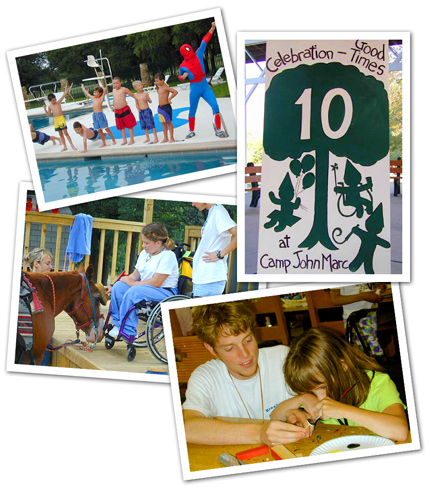 Big growth years
Big growth years
Every summer at Camp John Marc has a themed activity night. The theme during the summer of 2000 was “Birthday Celebration!” in honor of CJM’s 10th anniversary. 1,125 campers attended that summer, and the year ended with over $2 million in the organization’s endowment.
Also in 2000, the Family Getaway Weekend program was created by Vance and Assistant Director Kerry Brown. This program gives families with a child with a medical diagnosis (including cystic fibrosis) the opportunity to spend a self-guided weekend together at CJM. The addition of this program and other non-summer uses brought the total number of kids served during CJM’s tenth year to over 2,500.
During these years, new programs that are now synonymous with the CJM experience were introduced. Under the leadership of Board Member David Bell, an innovative therapeutic horse program began in 2000. And in 2004, a new ropes course was installed.
In 2004, the estate of Agnes Cluthe Oliver generously gave $200,000 to CJM. In 2005, a $300,000 grant from the Moss Heart Trust funded Camp Moss in full for three years. Because of generous gifts like these, CJM began planning for the biggest facility expansion since its initial construction.
In 2005, Board members Karl Rathjen and Carol Touchstone took on the challenge of a Capital Campaign to raise money for a new activity building at CJM. The Amon G. Carter Foundation gave $300,000 in honor of Paul Wallace, a Life Board Member and tireless volunteer. The Mabee Foundation issued a $250,000 challenge grant. Charles and Dana Nearburg and Trevor and Jan Rees-Jones each donated $150,000 in honor of Rett Nearburg, a former CJM camper who died of cancer at the age of 21. Ann and Bob Bass also made a gift of $60,000 towards construction in honor of loyal camp volunteer Sheila Johnson’s birthday.
Years 15-20 at CJM
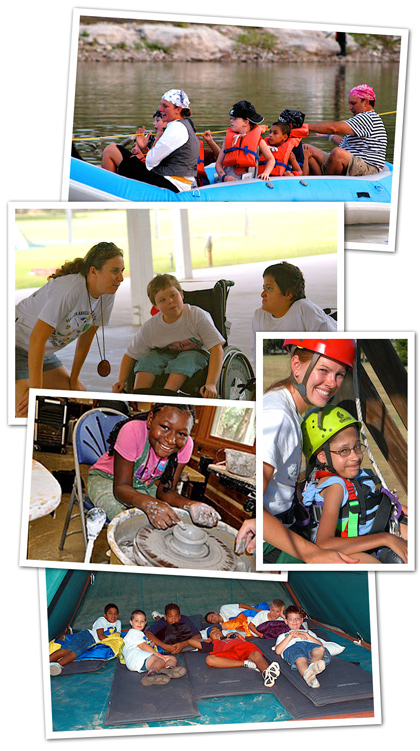 On solid ground
On solid ground
In 2006, Camp Jon Marc was re-accredited by the American Camping Association with a score of 99 out of a possible 100.
By 2007, Camp John Marc’s endowment reached $5 million. This was enough to ensure a long-term stable future for the organization. The annual Board campership fundraising drive continued to benefit CJM each year since its opening, but 2009 was an especially notable year of giving. Despite the recession, the Board managed to raise $610,000. Cook Children’s Medical Center of Fort Worth also gave a gift of $200,000 toward the new horse-riding arena in 2007.
In 2008, the new Activity Building, known as “the Silo,” was dedicated. More than 400 campers and their families, Camp John Marc staff and volunteers, and friends of CJM attended a special celebration in the amphitheater. The day even included a camper choir and 200 pounds of green and white confetti!
During this time, programming continued to expand. The inaugural Camp NOW, a camp for families who have a child with neuro-oncology organized by Cook Children’s Medical Center, was held in 2009. 2010 was the first year that Camp Morning Star, a bereavement camp for families who lost a child at Cook Children’s in the past 18 months, came to CJM.
As in 2000, a celebration was held during each week of Summer 2010 to honor CJM’s 20th anniversary. Each celebration night ended with a ceremonial lighting of a Live Oak tree that was strung with hundreds of twinkling lights. A larger community celebration was also held at the Texas Discovery Gardens. More than 500 people attended and listened to past CJM campers share stories about how they attribute their camp experiences to success in life.
Year 20 to Present at CJM
Into the future
Camp John Marc’s original logo, featuring busy campers under an oak tree, represented the organization well for 23 years. In 2011, a new logo, which reflects some of the ways CJM has grown and changed through the years, was unveiled.
A new practicum in Child Life was offered to CJM summer staff by Cook Children’s Medical Center. This exciting opportunity gives staff members interested in becoming child life specialists first hand experience. Summer staffers Erin Dellasega and Alli Gilmore were the first two participants in this educational endeavor.
The Board took on another Capital Campaign to tackle deferred maintenance and update facilities. Under the direction of Marc Myers in his first year as Board Chairman, the Board raised over $500,000 in a month. Soon after, the first project was completed—five miles of road were paved to improve the route to Camp John Marc. The new road is unofficially referred to as “The Pride of Bosque County.”
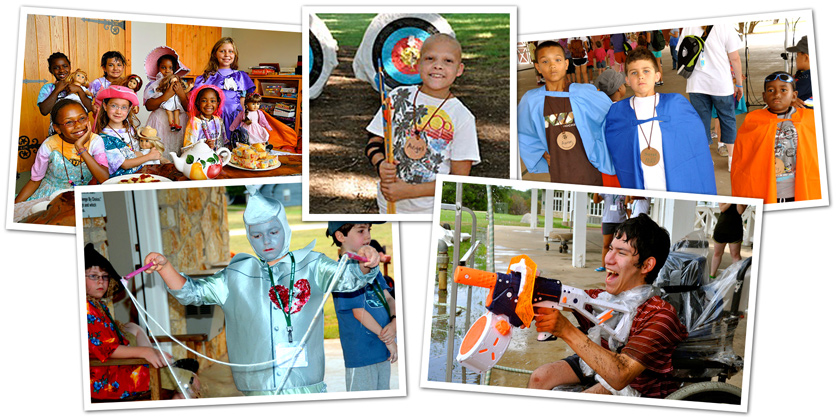
Camp by the Numbers
A growing impact
As of Summer 2014, Camp John Marc hosts eleven week-long summer camps and over 25 weekend camps during the year.
On average, camp serves 1,100 kids each summer and 3,000 kids and family members every year with an administrative staff of six, summer staff of 24 and the support of over 1,000 volunteers annually.

Leaders in Therapeutic Camping and Special Awards

Excellence recognized
Camp John Marc has twice been awarded the highest programming award given by the American Camping Association—The Eleanor P. Eells Award. The first award, given in 1993, recognized CJM for being the first organization in the country to serve H.I.V. positive kids and their families. In 1997, CJM was awarded its second Eells Award for award for outstanding programming related to the Phenylketonuria (PKU) family camp.
Through the years, CJM staff members and volunteers have also been individually honored for their work. Vane received the ACA’s Nation Service Award in 1999 and the National Honor Award in 2008. Karen Gilmore, camp photographer, has been nominated for two ACA golden lens awards for capturing special images of campers each summer, and Ryan Douglas, a former camper and CJM staff member from 2004-2007 was awarded the Jack Weiner Award and Scholarship from the ACA in 2004.
In 2004, Dr. Joann Sanders—pediatric oncologist, CJM Advisory Board Member and Camp Doctor for Camp Sanguinity—was chosen to receive the USA Freedom Corps Award in honor of her outstanding volunteer service. She accepted the award from President George W. Bush on the Love Field Airport tarmac near Air Force One.
CJM has also served as a therapeutic camping model for organizations across the country and abroad. Visitors have come from as close as Houston (Camp for All) and as far as Japan, Ghana and Australia to study CJM’s programming and facilities. In 2013, CJM hosted the Special Needs Kindred Group, in which representatives of 38 Special Needs Camps in 19 different states spent three days sharing and learning.
CJM Staff
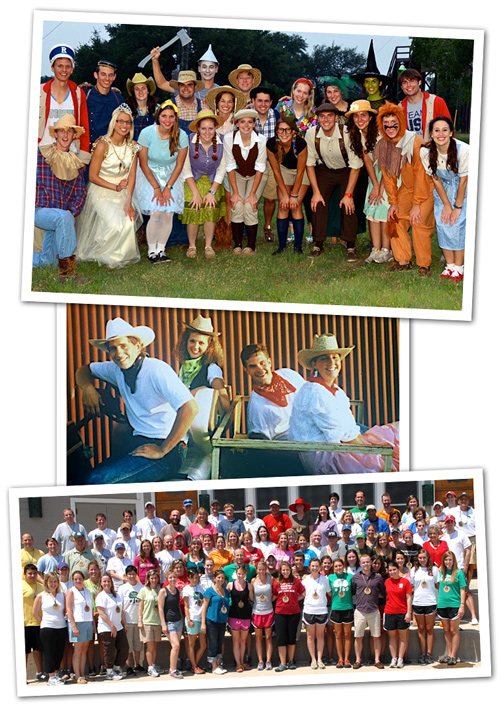 A true team effort
A true team effort
From 1991 to 2013, 265 individuals have served on a Camp John Marc summer staff. Choosing a fun, dedicated summer staff is important to each successful summer at Camp John Marc. Conversely, the camp experience often has a long-term impact on the lives of those who work at CJM.
After leaving camp, many former staffers go on to work in the medical field. Of the 265 CJM Alumni, 36 are Doctors, and 11 are currently in medical school. Four are Physician Assistants and two are currently in PA school. 18 are Nurses, and two are Nurse Practitioners. 19 are Child Life specialists; 16 are Recreational Therapists, and four are Occupational Therapists. There is also a Licensed Counselor, Dentist, Veterinarian and an Optometrist. Eight former staffers have pursued careers in camping.
Each year, outstanding staff members are recognized with awards or scholarships in memory of three tireless, giving individuals who were instrumental to the building of CJM and who personified its spirit and mission: Don Madsen, Ray Bean, and Paul Wallace. Summer staffers who exhibit similar exemplary dedication, enthusiasm, and/or leadership are honored with plaques on display at CJM. In all, over $30,000 has been given to the scholarship recipients.
In 2010, the first staff reunion was held in recognition of Camp John Marc’s 20th summer. More than 200 current and former staff members and their families travelled from eleven different states for the fun three-day event. Also in this year, long time Camp John Marc staff member Annie Shepard married former summer staff member Josh Stewart. They became the 10th couple to meet at Camp John Marc and marry.
Community
 Beyond the campground
Beyond the campground
Camp John Marc’s programming extends beyond its Bosque County home. Many events in the DFW area have been held through the years that serve the mission of CJM.
Each year, CJM hosts a picnic for Camp Jubilee campers and families. Twice a month, CJM volunteers and staff lead a Happy Camper program at Cook Children’s Hospital, which brings camp activities into hospital settings for patient enjoyment.
Especially important are events that recognize the relationships between CJM and local hospital staff and patients. In 2010, Jan Myers and Ann Miller, chaplain at Cook Children’s, hosted a tea to honor and recognize mothers who lost a child who was a camper at CJM. In 2012, CJM hosted a luncheon series for the leaders of CJM participating hospitals—Children’s Medical Center Dallas, Texas Scottish Rite Hospital and Cook Children’s Medical Center Fort Worth–in celebration of history, accomplishments and bonds shared.
Weather at CJM
 Rain or shine
Rain or shine
Because most camp activities are held outside, weather matters at Camp John Marc.
All Texans are familiar with heat, but two CJM summers stand out as especially hot and dry. In 2006, Crow Lake was depleted to a point where it could not be used, but thanks to creative programming changes (and a lot of time spent in the pool) the summer, and the fun, still went on. 2011 holds the record for the longest heat wave—it was over 100 degrees for 40 straight days that summer.
Surprisingly, rain has actually been a challenge during some summers. In 2004, it rained every day of Camp Sanguinity, yet CJM staffers and campers still managed to celebrate the 4th of July with fireworks and a Water War. Similarly, during the week of Camp Ailihpomeh in 2013, 8.4 inches of rain fell from Sunday to Wednesday.
Wildlife at CJM
 Close to nature
Close to nature
For many campers who live in large cities, Camp John Marc can be the first place they see a sky full of stars or a meadow full of wild bluebonnets. It’s also likely the first place they’ll glimpse a family of feeding deer. Numerous kinds of wild animals such as foxes, quail, snakes, toads, and the CJM nemesis chigger insect, all kindly share their home with the many domestic animals (including horses, goats, rabbits, turtles, and a dog named Bosque) that are cared for by CJM staff.
The Fort Worth Sportsman Club generously keeps Crow Lake stocked with perch, catfish, bass and carp. There is a legend about one huge, mythical catfish named Netter. Rod Cook, who was a University of Alabama student and staff member in 1991 (CJM’s inaugural summer), brought the story of Netter to life. When Rod returned to CJM in 1992 and 1993, the legend and reported size of Netter grew. Since then, the elusive catfish has remained the much-sought-after trophy of CJM fisherkids. Many campers claim to spot him every summer, but Netter has stealthily avoided captivity all these years.
All of CJM’s animal, nature, and catch-and-release fishing programs help campers better understand and value the natural environment.
CJM Improvements
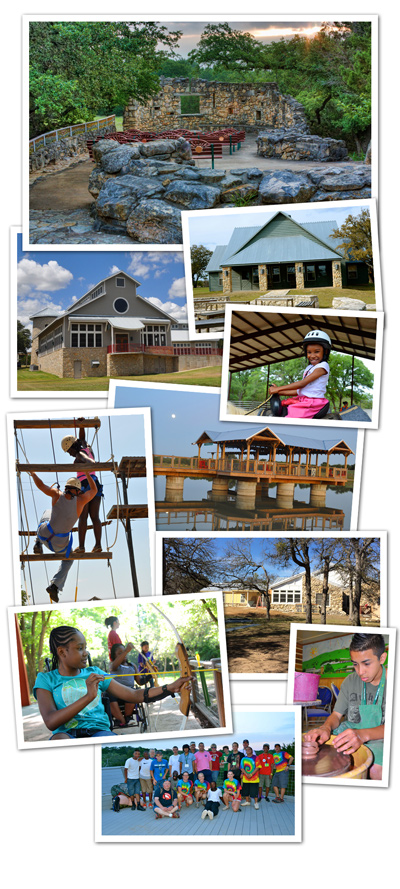 More milestones
More milestones
1995: Morning Star Chapel, an outdoor space constructed with Texas limestone and hand crafted-stained glass, was created as a place for gathering and contemplation. It’s also used each year as a special location to remember past campers that passed away during the year. The service to honor these campers is simple, but it always has an enormous impact on all in attendance.
1999: Staff and family Lodges were dedicated. Each lodge was named after an American Indian tribe and contains original watercolor artwork by Joan Scott, a former Camp John Marc Board Member and visual artist.
2004: A new ropes course (with a zipline over 300 feet long!) was unveiled and used for the first time.
2008: The multi-purpose activity building known as “the Silo” was completed this year. The 11,000 sq. foot building features several activity rooms, a photography dark room, a mural telling the story of John Marc Myers, a teaching kitchen, and an indoor climbing wall. The Silo was also built to serve as CJM’s emergency shelter; it can hold the entire camp population and withstand extreme weather conditions.
2009: Despite a downturn in the economy, an accessible fishing pier and a pottery studio were built in thanks to the Acorn Fund and the Sportsman’s Club of Fort Worth. The new pottery studio includes a beautiful mural of Camp with 200 pottery tools hidden in the image.
2010: David Bell, CJM Life Director, oversaw the creation of a new therapeutic horse arena. More than 70 people dance the Cotton Eyed Joe in the arena in appreciation of his efforts and in celebration of the new arena.
2011: A covered area with fans was added to the revamped archery range. Bathrooms were also added to this remote activity site.
2012: The Star Gazing Platform, which is especially popular during campouts, was redesigned and built.
2013: In addition to the road repaving, a major remodeling of the Medical Building also took place, and new housing for volunteers and the facility manager were also built.
Camp John Marc Leadership
In a class all their own

These individuals have provided outstanding leadership for Camp John Marc
through their role as Chair of the Camp John Marc Board:
Susan Williams 1988-1989
Randy Perry 1989-1992
Don Snell 1993-1994
Bob Spurgin 1995-1996
Jane Pierce 1996-1997
Craig Innes 1998-1999
Gary Huselton 2000-2001
Ellen McStay 2002-2003
Brooks Cullum 2004-2005
Carol Touchstone 2006-2007
Mike George 2008-2009
Ley Waggoner 2010-2011
Marc Myers 2012-2014
Rob Farrell 2015-2016
Scott Miller 2017-present